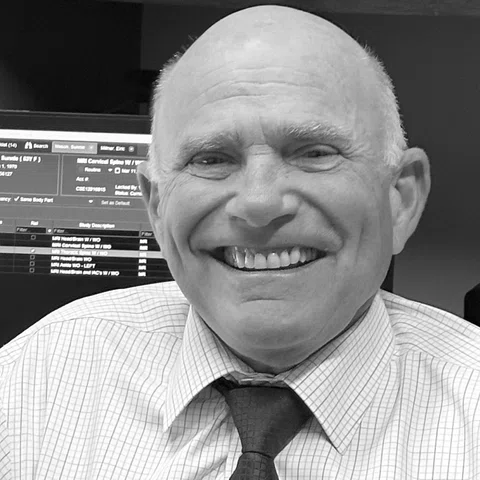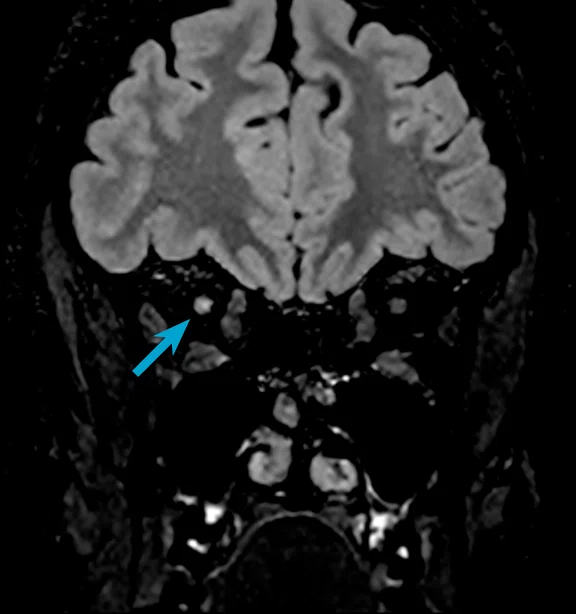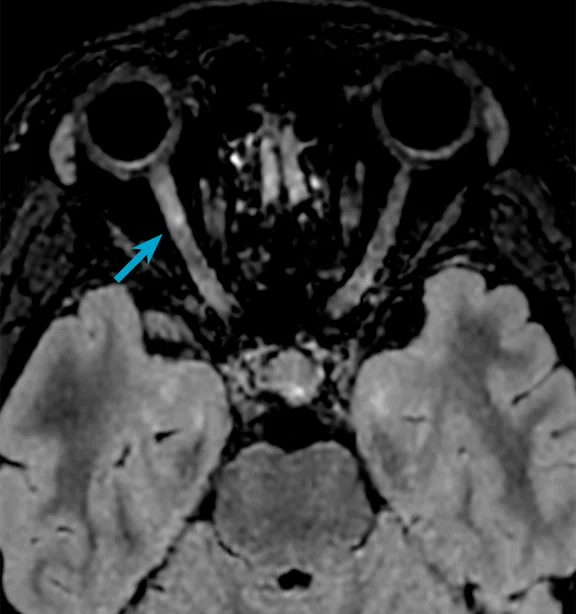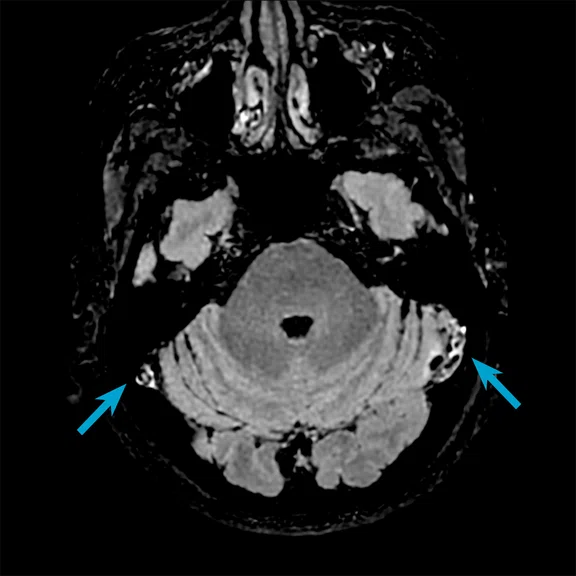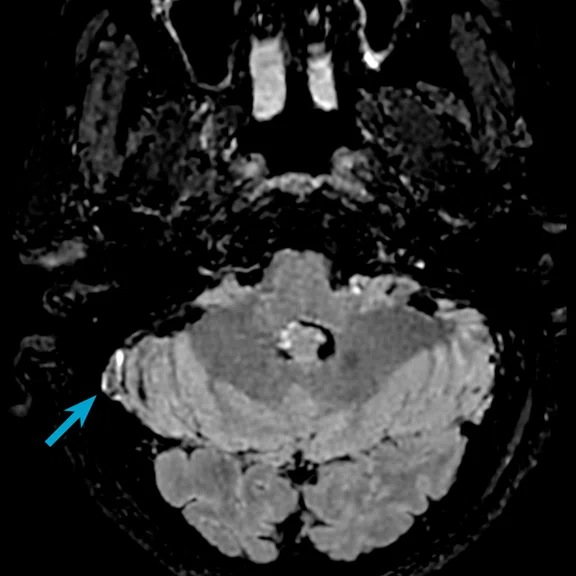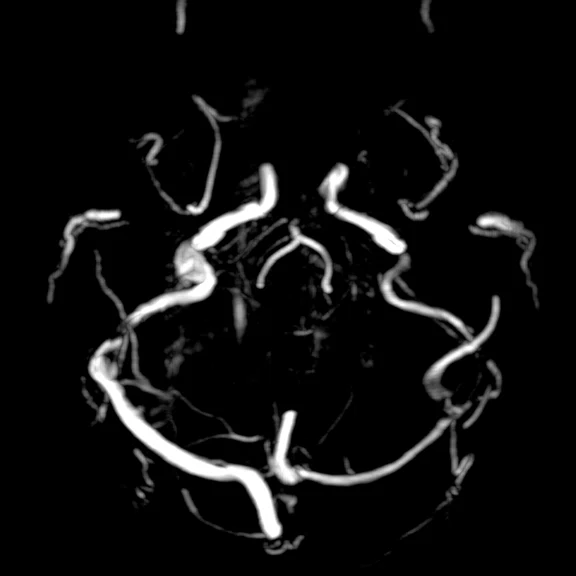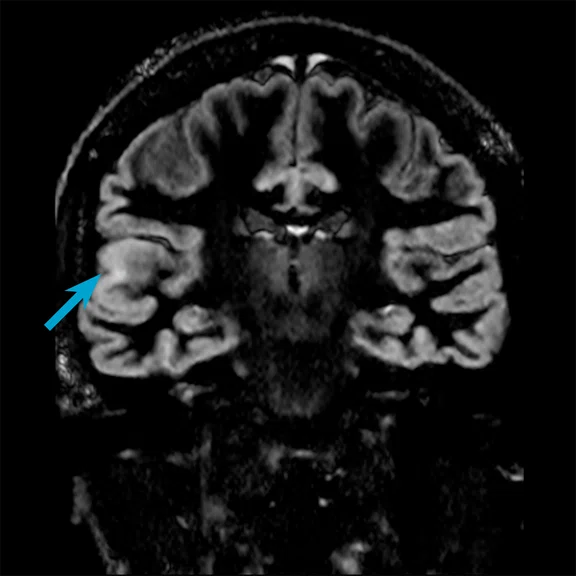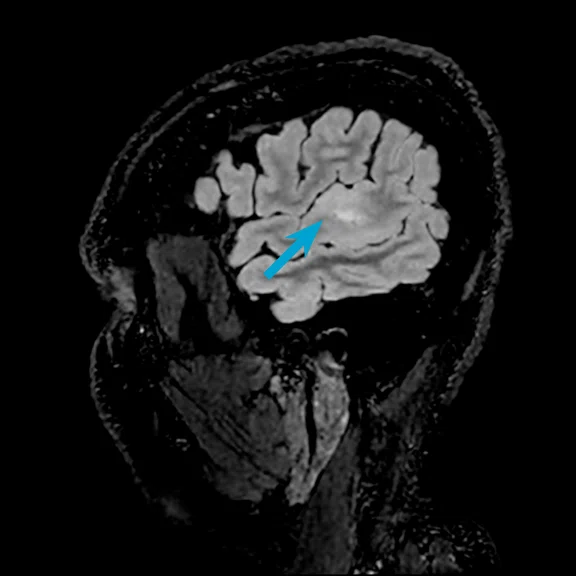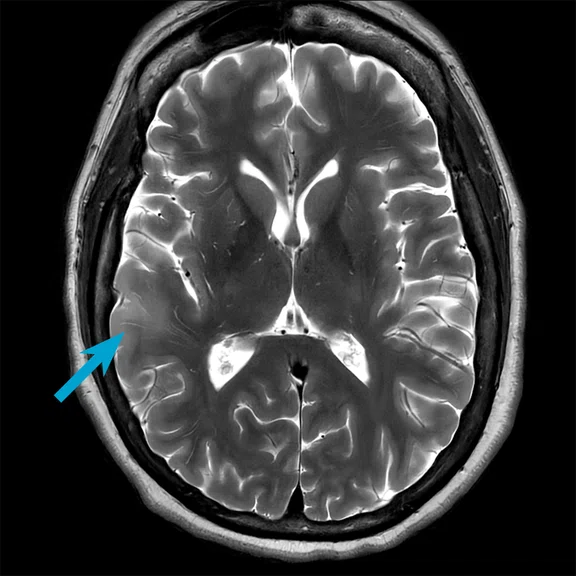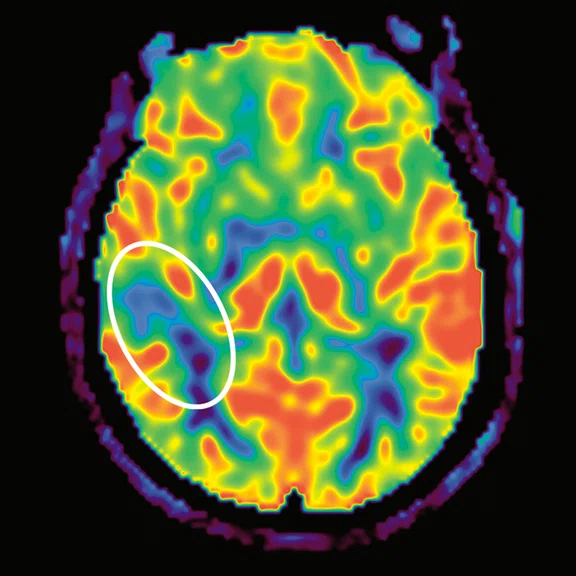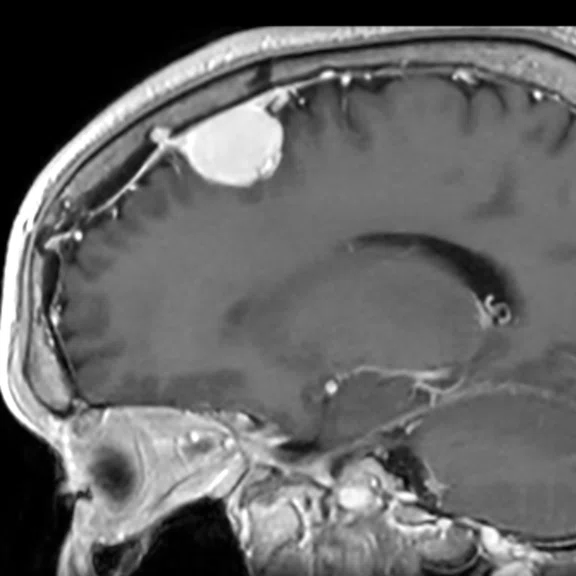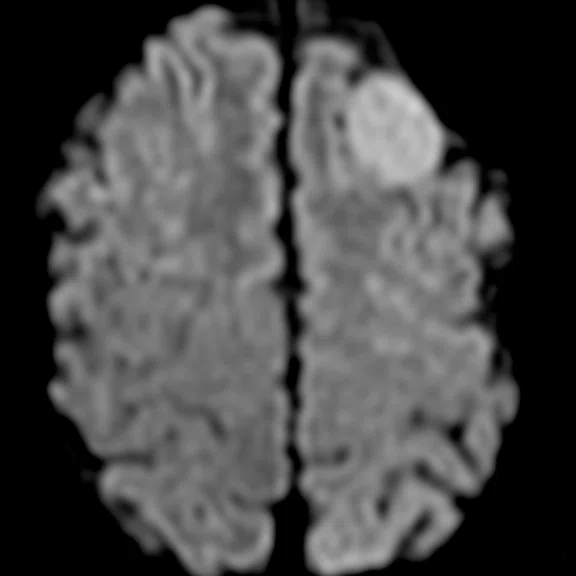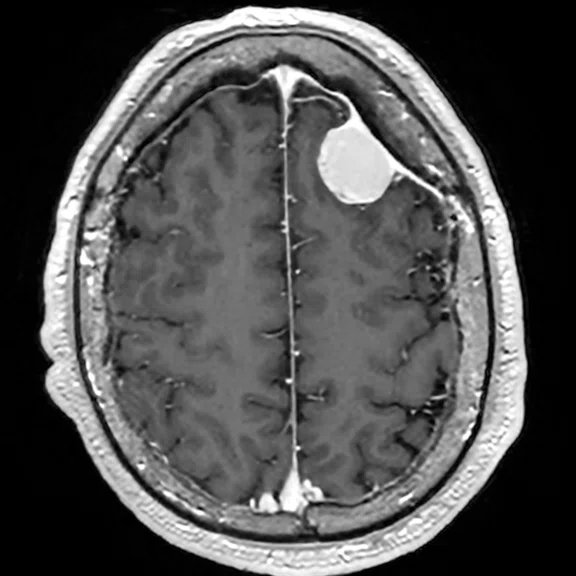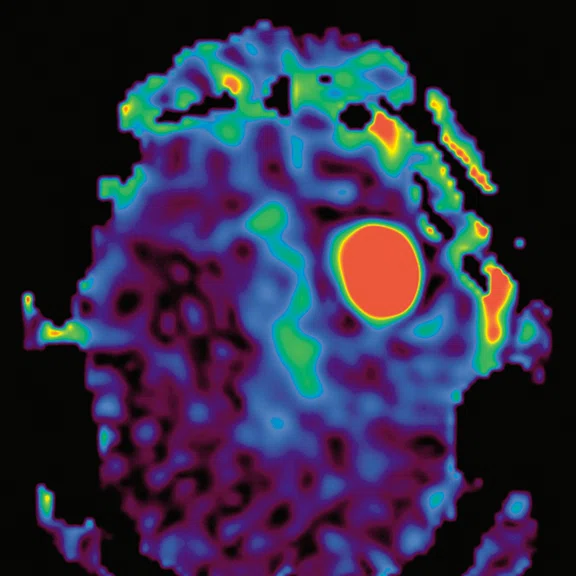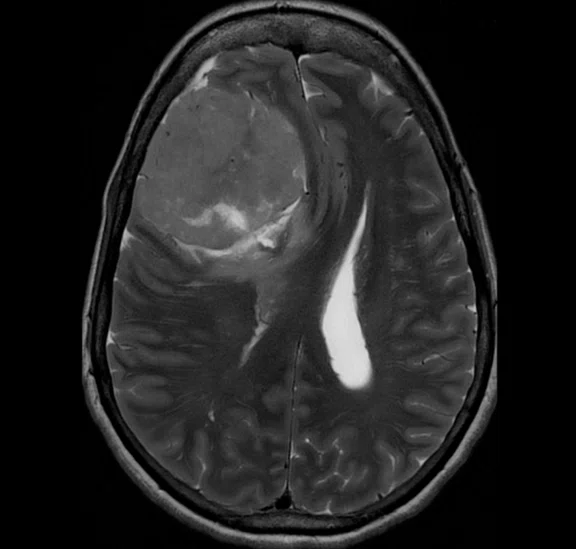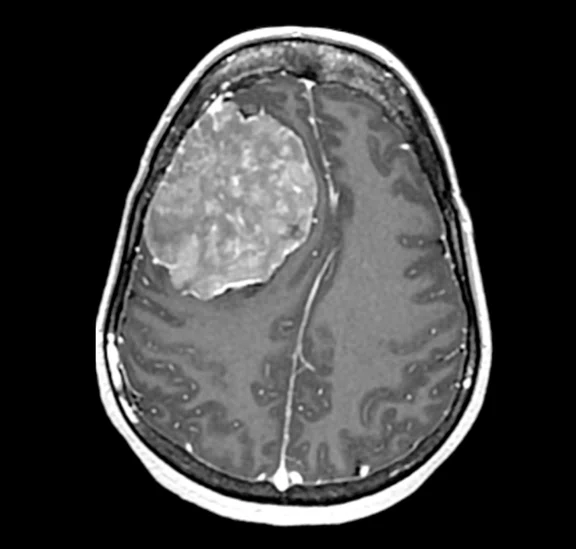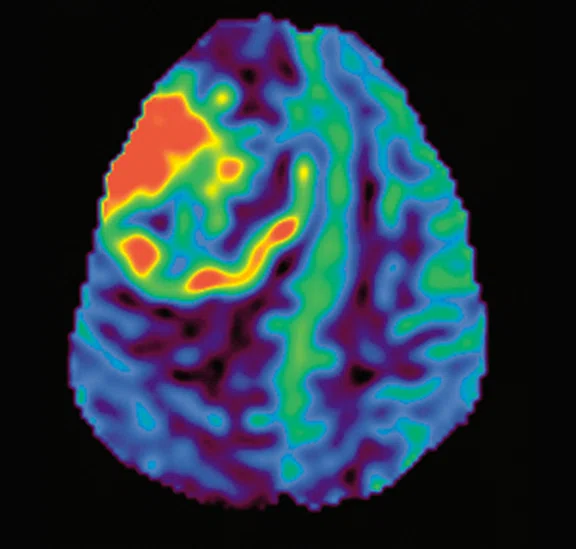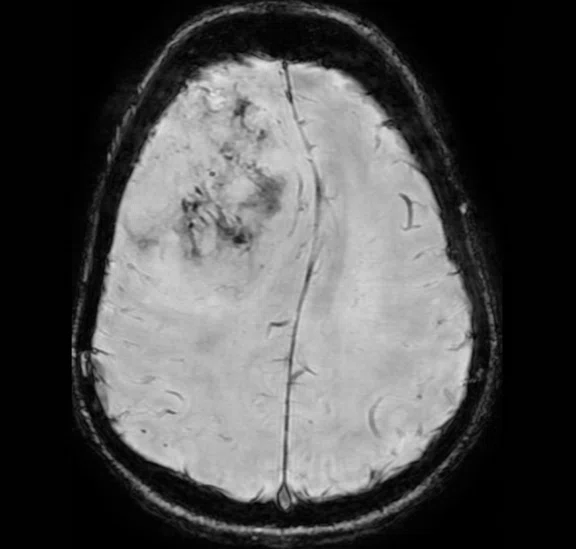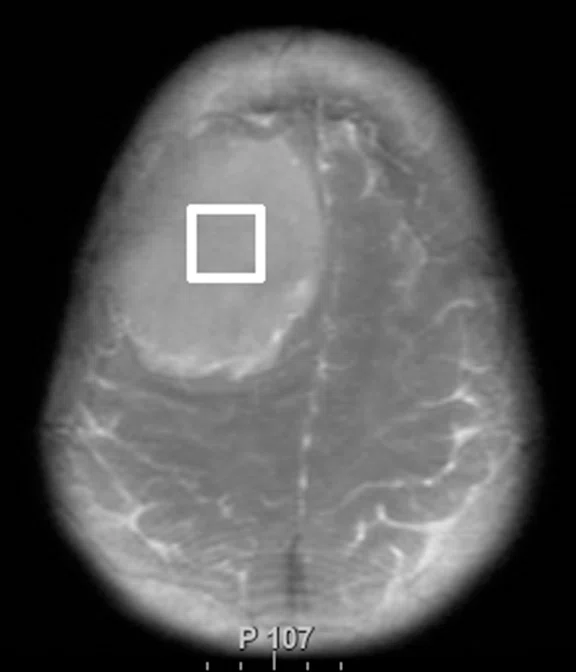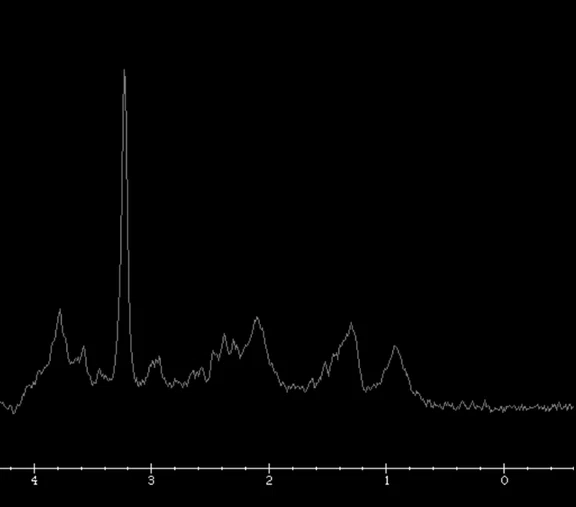A
Figure 1.
Patient with acute optic neuritis visualized on coronal and axial reformatted images from the sagittal T2 FLAIR Cube with AIR™ Recon DL, 1 x 1 x 1 mm, 300 slices, 2:49 min.
B
Figure 1.
Patient with acute optic neuritis visualized on coronal and axial reformatted images from the sagittal T2 FLAIR Cube with AIR™ Recon DL, 1 x 1 x 1 mm, 300 slices, 2:49 min.
A
Figure 2.
Patient with bilateral venous thrombosis of the transverse sinus. (A, B) Axial images reconstructed from the sagittal T2 FLAIR Cube with AIR™ Recon DL, 1 x 1 x 1 mm, 300 slices, 2:49 min.; and (C) axial MIP from the sagittal Inhance 3D Velocity sequence , 0.8 x 0.8 x 1.4 mm, 230 slices, 5:30 min., venc=15 cm/sec.
B
Figure 2.
Patient with bilateral venous thrombosis of the transverse sinus. (A, B) Axial images reconstructed from the sagittal T2 FLAIR Cube with AIR™ Recon DL, 1 x 1 x 1 mm, 300 slices, 2:49 min.; and (C) axial MIP from the sagittal Inhance 3D Velocity sequence , 0.8 x 0.8 x 1.4 mm, 230 slices, 5:30 min., venc=15 cm/sec.
C
Figure 2.
Patient with bilateral venous thrombosis of the transverse sinus. (A, B) Axial images reconstructed from the sagittal T2 FLAIR Cube with AIR™ Recon DL, 1 x 1 x 1 mm, 300 slices, 2:49 min.; and (C) axial MIP from the sagittal Inhance 3D Velocity sequence , 0.8 x 0.8 x 1.4 mm, 230 slices, 5:30 min., venc=15 cm/sec.
A
Figure 3.
A 36-year-old female experiencing seizures, diagnosed with cortical dysplasia. Hypoperfusion is depicted on the ASL. (A) Sagittal CUBE DIR with AIR™ Recon DL, showing coronal reformat, 1.2 x 1.2 x 0.8 mm, 292 slices, 2:54 min.; (B) sagittal T2 FLAIR Cube with AIR™ Recon DL, 1 x 1 x 1 mm, 300 slices, 2:49 min.; (C) axial T2 PROPELLER with AIR™ Recon DL, 0.4 x 0.4 x 3 mm, 32 slices, 3:44 min.; and (D) axial ASL, showing CBF Flow Map, 512 x 8, 5 mm, 36 slices, 3:02 min.
B
Figure 3.
A 36-year-old female experiencing seizures, diagnosed with cortical dysplasia. Hypoperfusion is depicted on the ASL. (A) Sagittal CUBE DIR with AIR™ Recon DL, showing coronal reformat, 1.2 x 1.2 x 0.8 mm, 292 slices, 2:54 min.; (B) sagittal T2 FLAIR Cube with AIR™ Recon DL, 1 x 1 x 1 mm, 300 slices, 2:49 min.; (C) axial T2 PROPELLER with AIR™ Recon DL, 0.4 x 0.4 x 3 mm, 32 slices, 3:44 min.; and (D) axial ASL, showing CBF Flow Map, 512 x 8, 5 mm, 36 slices, 3:02 min.
C
Figure 3.
A 36-year-old female experiencing seizures, diagnosed with cortical dysplasia. Hypoperfusion is depicted on the ASL. (A) Sagittal CUBE DIR with AIR™ Recon DL, showing coronal reformat, 1.2 x 1.2 x 0.8 mm, 292 slices, 2:54 min.; (B) sagittal T2 FLAIR Cube with AIR™ Recon DL, 1 x 1 x 1 mm, 300 slices, 2:49 min.; (C) axial T2 PROPELLER with AIR™ Recon DL, 0.4 x 0.4 x 3 mm, 32 slices, 3:44 min.; and (D) axial ASL, showing CBF Flow Map, 512 x 8, 5 mm, 36 slices, 3:02 min.
D
Figure 3.
A 36-year-old female experiencing seizures, diagnosed with cortical dysplasia. Hypoperfusion is depicted on the ASL. (A) Sagittal CUBE DIR with AIR™ Recon DL, showing coronal reformat, 1.2 x 1.2 x 0.8 mm, 292 slices, 2:54 min.; (B) sagittal T2 FLAIR Cube with AIR™ Recon DL, 1 x 1 x 1 mm, 300 slices, 2:49 min.; (C) axial T2 PROPELLER with AIR™ Recon DL, 0.4 x 0.4 x 3 mm, 32 slices, 3:44 min.; and (D) axial ASL, showing CBF Flow Map, 512 x 8, 5 mm, 36 slices, 3:02 min.
1. Wattjes MP, Ciccarelli O, Reich DS, et al. Magnetic Resonance Imaging in Multiple Sclerosis study group; Consortium of Multiple Sclerosis Centres; North American Imaging in Multiple Sclerosis Cooperative MRI guidelines working group. 2021 MAGNIMS-CMSC-NAIMS consensus recommendations on the use of MRI in patients with multiple sclerosis. Lancet Neurol. 2021 Aug;20(8):653-670.
2. Shams S, Fällmar D, Schwarz S, et al. MRI of the Swallow Tail Sign: A Useful Marker in the Diagnosis of Lewy Body Dementia? AJNR Am J Neuroradiol. 2017 Sep;38(9):1737-1741.
A
Figure 4.
Patient with meningioma causing erosion of the skull. There is invasion and chronic thrombosis of a short segment of the superior sagittal sinus. ASL demonstrates intense perfusion. (A) Post-contrast sagittal T1 with AIR™ Recon DL, 1 x 1 x 3 mm, 2:48 min.; (B) axial diffusion with AIR™ Recon DL, 1.7 x 2.2 x 3 mm, 1:16 min.; (C) post-contrast axial MP-RAGE with AIR™ Recon DL, 1 x 1 x 1 mm, 2:48 min.; and (D) Axial ASL – CBF Flow Map, 512 x 8 x 4 mm, 4:15 min.
B
Figure 4.
Patient with meningioma causing erosion of the skull. There is invasion and chronic thrombosis of a short segment of the superior sagittal sinus. ASL demonstrates intense perfusion. (A) Post-contrast sagittal T1 with AIR™ Recon DL, 1 x 1 x 3 mm, 2:48 min.; (B) axial diffusion with AIR™ Recon DL, 1.7 x 2.2 x 3 mm, 1:16 min.; (C) post-contrast axial MP-RAGE with AIR™ Recon DL, 1 x 1 x 1 mm, 2:48 min.; and (D) Axial ASL – CBF Flow Map, 512 x 8 x 4 mm, 4:15 min.
C
Figure 4.
Patient with meningioma causing erosion of the skull. There is invasion and chronic thrombosis of a short segment of the superior sagittal sinus. ASL demonstrates intense perfusion. (A) Post-contrast sagittal T1 with AIR™ Recon DL, 1 x 1 x 3 mm, 2:48 min.; (B) axial diffusion with AIR™ Recon DL, 1.7 x 2.2 x 3 mm, 1:16 min.; (C) post-contrast axial MP-RAGE with AIR™ Recon DL, 1 x 1 x 1 mm, 2:48 min.; and (D) Axial ASL – CBF Flow Map, 512 x 8 x 4 mm, 4:15 min.
D
Figure 4.
Patient with meningioma causing erosion of the skull. There is invasion and chronic thrombosis of a short segment of the superior sagittal sinus. ASL demonstrates intense perfusion. (A) Post-contrast sagittal T1 with AIR™ Recon DL, 1 x 1 x 3 mm, 2:48 min.; (B) axial diffusion with AIR™ Recon DL, 1.7 x 2.2 x 3 mm, 1:16 min.; (C) post-contrast axial MP-RAGE with AIR™ Recon DL, 1 x 1 x 1 mm, 2:48 min.; and (D) Axial ASL – CBF Flow Map, 512 x 8 x 4 mm, 4:15 min.
A
Figure 5.
Patient with H/O meningioma and chronic calcified meningioma. (A) Axial T2 PROPELLER with AIR™ Recon DL, 0.4 x 0.4 x 3 mm, 50 slices, 3:02 min.; (B) axial 3D BRAVO with AIR™ Recon DL, 1.0 x 1.0 x 1.2 mm, 160 slices, 3:05 min.; (C) axial ASL – CBF Flow Map, 512 x 8 x 4, 4 mm, 36 slices, 4:16 min.; and (D) axial 3D SWAN, 0.6 x 0.8 x 1.5 mm, 76 slices, 3:10 min.
B
Figure 5.
Patient with H/O meningioma and chronic calcified meningioma. (A) Axial T2 PROPELLER with AIR™ Recon DL, 0.4 x 0.4 x 3 mm, 50 slices, 3:02 min.; (B) axial 3D BRAVO with AIR™ Recon DL, 1.0 x 1.0 x 1.2 mm, 160 slices, 3:05 min.; (C) axial ASL – CBF Flow Map, 512 x 8 x 4, 4 mm, 36 slices, 4:16 min.; and (D) axial 3D SWAN, 0.6 x 0.8 x 1.5 mm, 76 slices, 3:10 min.
C
Figure 5.
Patient with H/O meningioma and chronic calcified meningioma. (A) Axial T2 PROPELLER with AIR™ Recon DL, 0.4 x 0.4 x 3 mm, 50 slices, 3:02 min.; (B) axial 3D BRAVO with AIR™ Recon DL, 1.0 x 1.0 x 1.2 mm, 160 slices, 3:05 min.; (C) axial ASL – CBF Flow Map, 512 x 8 x 4, 4 mm, 36 slices, 4:16 min.; and (D) axial 3D SWAN, 0.6 x 0.8 x 1.5 mm, 76 slices, 3:10 min.
D
Figure 5.
Patient with H/O meningioma and chronic calcified meningioma. (A) Axial T2 PROPELLER with AIR™ Recon DL, 0.4 x 0.4 x 3 mm, 50 slices, 3:02 min.; (B) axial 3D BRAVO with AIR™ Recon DL, 1.0 x 1.0 x 1.2 mm, 160 slices, 3:05 min.; (C) axial ASL – CBF Flow Map, 512 x 8 x 4, 4 mm, 36 slices, 4:16 min.; and (D) axial 3D SWAN, 0.6 x 0.8 x 1.5 mm, 76 slices, 3:10 min.
3. Huang M, Yu H, Cai X et al. A comparative study of posterior cingulate metabolism in patients with mild cognitive impairment due to Parkinson›s disease or Alzheimer›s disease. Sci Rep. 2023 Aug 30;13(1):14241.
A
Figure 6.
Same patient as Figure 5. (A) Axial T2 SSFSE localizer with AIR™ Recon DL, 21 slices, 21 sec. and (B) single voxel spectroscopy showing marked elevation of choline, with marked reduction of NAA and CR. Elevation on graph at 1.2-1.3 is consistent with alanine.
B
Figure 6.
Same patient as Figure 5. (A) Axial T2 SSFSE localizer with AIR™ Recon DL, 21 slices, 21 sec. and (B) single voxel spectroscopy showing marked elevation of choline, with marked reduction of NAA and CR. Elevation on graph at 1.2-1.3 is consistent with alanine.
4. Agarwal A, Gupta V, Brahmbhatt P, et al. Amyloid-related Imaging Abnormalities in Alzheimer Disease Treated with Anti-Amyloid-β Therapy. Radiographics. 2023 Sep;43(9):e230009.
5. Haller S, Haacke EM, Thurnher MM, Barkhof F. Susceptibility-weighted imaging: technical essentials and clinical neurologic applications. Radiology. 2021 Apr;299(1):3-26.
6. Kummari S, Burra KG, Reddy VR, Das S, Anilkumar C. Determination of Efficiency of 3D Fluid-Attenuated Inversion Recovery (FLAIR) in the Imaging of Multiple Sclerosis in Comparison With 2D FLAIR at 3-Tesla MRI. Cureus. 2023 Nov 1;15(11):e48136.
result


PREVIOUS
${prev-page}
NEXT
${next-page}
Subscribe Now
Manage Subscription
FOLLOW US
Contact Us • Cookie Preferences • Privacy Policy • California Privacy PolicyDo Not Sell or Share My Personal Information • Terms & Conditions • Security
© 2024 GE HealthCare. GE is a trademark of General Electric Company. Used under trademark license.
In Practice
Investing in cutting-edge MR technology helps Envision Radiology be a hero to patients
Investing in cutting-edge MR technology helps Envision Radiology be a hero to patients
As a leading outpatient diagnostic imaging organization with several locations across six states, Envision Radiology delivers world-class services with cutting-edge technologies. At its Colorado Springs location, Colorado Springs Imaging, the organization has a SIGNA™ HDx 1.5T system, Optima™ MR450w 1.5T system and one of the first SIGNA™ Hero 3.0T systems installed in the US.
“The technology changes introduced by GE HealthCare in MR have been revolutionary and game-changing,” says Jeff Amsden, Vice President of Operations. “We saw how the SIGNA™ Hero could change our business by helping us be at the forefront with technology that can help us grow.”
Colorado Springs is one of the largest military towns in the US, home to the US Air Force Academy, Fort Carson and the largest contingent of space service military installations. As such, Colorado Springs Imaging has a large patient base of active-duty troops, retired veterans and reservists. Choosing a wide-bore system with AIR™ Recon DL to enable a more comfortable, shorter scan was key for the center.
“We see a lot of patients with PTSD, claustrophobia and anxiety,” Amsden says. “The comfort of a wide bore and a shorter scan makes it a lot easier on the patient.” Amsden believes that acquiring cutting-edge technology is a key driver enabling Envision Radiology to give the best possible patient care.
A hero for technologists
SIGNA™ Hero was built to handle the toughest challenges and make difficult MR imaging exams simpler with advanced technologies such as AIR™ Recon DL, AIR x™ and AIR Touch™ that also improve the scanning experience.
According to Matt Schroetlin, RT(R)(CT)(MR), Lead Multi-Modality Technologist, and Ashlee Montoya, RT(R)(CT)(MR), Multi-Modality Technologist, they no longer have to balance scan time with quality thanks to AIR™ Recon DL. AIR™ Recon DL is GE HealthCare’s industry-leading, deep-learning technology that removes noise and ringing from raw images and improves signal-to-noise ratio (SNR), allowing scan time reductions by up to 50%.
“It’s game-changing technology,” says Schroetlin. “We have a five-sequence lumbar spine that takes 10 minutes. Some imaging centers I’ve worked at can take up to 30 minutes for this same exam.” Most knee exams average 15 minutes, he adds.
Further streamlining both knee and brain exams is AIR x™, a deep-learning algorithm that automatically detects patient anatomy and prescribes MR slices, delivering consistent and quantifiable results. Not all technologists have the same level of experience and some may have difficulty positioning the patient the exact same way. The automated workflow creates efficiency and reproduces steps used in planning to ensure exam efficiency for same patient follow-up.
Figure 2.
Patient with bilateral venous thrombosis of the transverse sinus. (A, B) Axial images reconstructed from the sagittal T2 FLAIR Cube with AIR™ Recon DL, 1 x 1 x 1 mm, 300 slices, 2:49 min.; and (C) axial MIP from the sagittal Inhance 3D Velocity sequence , 0.8 x 0.8 x 1.4 mm, 230 slices, 5:30 min., venc=15 cm/sec.
“AIR x™ just makes our scanning more consistent,” says Montoya. “Some of us angle different ways and it makes sure that the doctor is getting the same images every time.” The technology is most important in longitudinal studies, such as neurodegenerative disease evaluations or in pre- and post-surgery knee examinations.
AIR™ Touch is another GE HealthCare intelligent workflow solution that has simplified scan setup by optimizing the element configuration for uniformity, SNR and parallel imaging. It selects the best MR coil element combination for each patient over a precise volume-of-interest. At Colorado Springs Imaging, AIR™ Touch is also used on every patient, so the technologists can complete exams faster and patients spend less time on the table.
Montoya also uses the in-room display, which saves time while allowing her to spend more time bedside with the patient. The detachable table is another efficiency booster for patients who are having both a CT and a MR exam at the center. Technologists can detach the table and take it to the CT suite, then move patients right over onto the CT table.
The detachable table also helps in instances where the patient needs to be moved quickly out of the MR scanning room. John L. Sherman, MD, Medical Director, recalls a few instances where patients had a reaction or seizure, and the team could separate the table from the MR scanner and quickly move the patient out of the MR room.
Colorado Springs Imaging also has an AIR™ Anterior Array (AA) Coil and one each of the AIR™ Multi-Purpose (MP) 21-channel and 20-channel coils.
“The AIR™ AA Coil is great because we don’t have to move it inferior to superior when doing abdomen or pelvis studies,” says Schroetlin. “It is lightweight, so patients don’t feel as claustrophobic.” He and Montoya have used the 21-channel coil in knee exams on patients who couldn’t fit into the conventional hard knee coil.
“These coils are super versatile and give us more options for patients, so we don’t have to turn them away or abort a study based on their body habitus,” he says.
“The image quality from these coils and the addition of AIR™ Recon DL is great,” adds Montoya. “We don’t have to worry about rescans or repositioning patients with these two technologies.”
Dr. Sherman has not noticed any artifacts in images that can occur when the coil elements are not close to the region of interest or in cases of improper coil or patient positioning.
“I was blown away the first time I saw us using these AIR™ Coils – they are like blankets,” Dr. Sherman says. “It’s amazing how good the quality is and the flexibility of those coils and how easy they are to hold and manipulate.”
While many technologists and imaging centers run behind on their MR schedule due to patient or exam complexity, Schroetlin says that is not the case at Colorado Spring Imaging thanks to technologies such as SIGNA™ Hero and AIR™ Recon DL.
“We don’t fall behind anymore,” Schroetlin adds. “We can do more scanning and more coverage in less time than before.” Hand or wrist exams, for example, are now completed in half the time than previous exams.
In fact, the scan times are so fast with SIGNA™ Hero that Colorado Springs Imaging hired a medical assistant to help switch the room over and get the patient on and off the table.
“Getting the patient set up really takes the longest,” says Montoya. “We have better image quality and decreased scan times – you can’t beat that.”
Figure 3.
A 36-year-old female experiencing seizures, diagnosed with cortical dysplasia. Hypoperfusion is depicted on the ASL. (A) Sagittal CUBE DIR with AIR™ Recon DL, showing coronal reformat, 1.2 x 1.2 x 0.8 mm, 292 slices, 2:54 min.; (B) sagittal T2 FLAIR Cube with AIR™ Recon DL, 1 x 1 x 1 mm, 300 slices, 2:49 min.; (C) axial T2 PROPELLER with AIR™ Recon DL, 0.4 x 0.4 x 3 mm, 32 slices, 3:44 min.; and (D) axial ASL, showing CBF Flow Map, 512 x 8, 5 mm, 36 slices, 3:02 min.
Advanced neuro imaging
Dr. Sherman has worked with other 3.0T systems in his career, yet SIGNA™ Hero has impressed him with the array of technologies and tools at his disposal.
“SIGNA™ Hero really improves my ability to do cutting-edge neuroradiology comparable to anything done at academic institutions. I can make observations that are sometimes outside of the routine, such as making a diagnosis of unsuspected idiopathic intracranial hypertension in a headache patient,” he says. “I wish I had all these tools sooner.”
Dr. Sherman’s favorite sequence is the 3D FLAIR Cube with AIR™ Recon DL. Because the image quality is so good, he can often see things that he hasn’t been asked to detect. For example, he may be asked to review a routine brain exam without adequate clinical information and is nevertheless able to detect optic neuritis, trigeminal neuritis, cortical dysplasia, etc., because of the high image quality. 3D FLAIR Cube is the recommended sequence by the Consortium of Multiple Sclerosis Centers in the US.1
“I can look at the optic nerves with the 3D FLAIR and find optic neuritis,” Dr. Sherman explains. “We don’t have to acquire a coronal STIR on those optic nerves all the time. The same with the trigeminal nerves, where I can see edema on a non-contrast study. I couldn’t make that diagnosis without that 3D FLAIR – the 2D FLAIR is just not as good.”
SWAN is another key neuroimaging sequence that improves Dr. Sherman’s detection of small microbleeds and hemosiderin deposition in the meninges. “I can look for an absent ‘swallow tail sign’ in a patient with tremor and can help the neurologist make a diagnosis of Parkinson’s disease,” he adds.2
“If I had to have only one sequence, it would be SWAN because it picks up T2 lesions, microbleeds, vascular information and (structural) anatomy,” says Dr. Sherman. “That sequence is dynamite.”
Another important sequence for Dr. Sherman is ASL, which provides him with a level of information he can’t get from other non-contrast studies. It’s used across many neuro indications – dementia, oncology, trauma and seizure workups. He explains that ASL is especially sensitive to meningiomas, AVMs and fistulas, and it helps him differentiate treated glioblastoma “pseudotumor” from recurrent glioblastoma, high-grade tumors from low-grade tumors, and benign tissue like cortical dysplasia from malignant tumors. In meningiomas, ASL provides an additional parameter to help predict an inactive low-grade tumor from a more aggressive tumor. ASL also enables detection of small isointense meningiomas on non-contrast studies where the tumor is frequently isointense compared to normal tissue.
Figure 4.
Patient with meningioma causing erosion of the skull. There is invasion and chronic thrombosis of a short segment of the superior sagittal sinus. ASL demonstrates intense perfusion. (A) Post-contrast sagittal T1 with AIR™ Recon DL, 1 x 1 x 3 mm, 2:48 min.; (B) axial diffusion with AIR™ Recon DL, 1.7 x 2.2 x 3 mm, 1:16 min.; (C) post-contrast axial MP-RAGE with AIR™ Recon DL, 1 x 1 x 1 mm, 2:48 min.; and (D) Axial ASL – CBF Flow Map, 512 x 8 x 4 mm, 4:15 min.
Envision has utilized all these sequences to develop a multiparametric, high-end DTI 32-direction protocol for traumatic brain injury imaging. In addition to 3D FLAIR Cube, SWAN, ASL and T2 PROPELLER, the protocol also includes DWI, DTI and the standard 3D T1, the latter being required for NeuroQuant® analysis. The team estimates that 55 to 60% of its patients are from the military, with many active-duty members, leading to a high demand of mTBI and TBI imaging.
For more routine brain exams, the protocol is simplified to 15-directions and 2 mm DTI. With the 2 mm DTI, Schroetlin can generate sagittal, axial and coronal FA maps in approximately 1 minute using Ready View, available with SIGNA™ Hero.
“These studies are often non-specific on standard studies, but if one or more of the SWAN, DTI, MR spectroscopy or NeuroQuant® parameters are abnormal, it increases my confidence in making a diagnosis of TBI. So many of these TBI patients have negative CTs and MRIs. This is a way of providing something that is more sensitive and specific,” Dr. Sherman says.
In pediatric neuro imaging for head injuries, the team has developed a protocol that acquires more information in a stepwise fashion using 1-minute, 3-minute, 5-minute or 10-minute protocols without sedation or contrast. It is a protocol requested by pediatricians who want to avoid radiation, sedation and intravenous injections in their non-hospitalized patients.
“It’s hit or miss how cooperative these kids are going to be, so at a minimum we can capture echo planar and T2 PROPELLER imaging for almost anyone without using sedation,” Dr. Sherman says. If the child is cooperative, then they can acquire the full standard brain protocol in 10 minutes or less.
“With SIGNA™ Hero, we are getting better quality images and higher SNR to visualize more pathology, and we can do it in less time,” Dr. Sherman says.
Figure 5.
Patient with H/O meningioma and chronic calcified meningioma. (A) Axial T2 PROPELLER with AIR™ Recon DL, 0.4 x 0.4 x 3 mm, 50 slices, 3:02 min.; (B) axial 3D BRAVO with AIR™ Recon DL, 1.0 x 1.0 x 1.2 mm, 160 slices, 3:05 min.; (C) axial ASL – CBF Flow Map, 512 x 8 x 4, 4 mm, 36 slices, 4:16 min.; and (D) axial 3D SWAN, 0.6 x 0.8 x 1.5 mm, 76 slices, 3:10 min.
For dementia patients, Colorado Springs Imaging will use several aspects of the multiparametric advanced protocol, such as ASL for reduced perfusion in the posterior cingulate gyri and the 3D T1 for hippocampal atrophy using NeuroQuant®. They add MR spectroscopy to look for reduced n-acetyl asparate (NAA) signals and elevated myo-inositol in the posterior cingulate gyrus in Alzheimer’s disease patients. If Dr. Sherman sees correlating abnormalities from the ASL, MR spectroscopy and quantitative volumetric analysis, then he can significantly increase the accuracy of the neurologist in making a diagnosis of early Alzheimer’s disease. The patterns of these various parameters help in the differentiation of the various dementias.3
As the center prepares for the expected influx of patients needing amyloid-related imaging abnormalities (ARIA) imaging after anti-amyloid therapy for Alzheimer’s disease, Dr. Sherman and Schroetlin have been thinking about how they can handle additional neuroimaging volumes along with declining reimbursement.
These patients will require five to six MR studies to look for ARIA over the course of their anti-amyloid monoclonal antibody treatment. Dr. Sherman agrees that the first study should be a comprehensive neuro MR exam to capture the patient’s baseline condition. For the subsequent studies, a case can be made to limit the exam to SWAN and 3D T2w Cube, which will help Dr. Sherman confidently detect ARIA-E and ARIA-H,4 and then possibly combine with a 30-second DWI.
“If we want to know if the patient is having a complication, we’ll have it with the SWAN and 3D FLAIR Cube,” Dr. Sherman says. “The literature shows SWAN/SWI is far better than the T2* GRE5 and 3D FLAIR is superior to 2D FLAIR.6 I think this shortened protocol will be cost-effective for the payer and easy to deliver to the providers, especially when using a system like SIGNA™ Hero with AIR™ Recon DL.”
For Amsden, whether it’s imaging dementia patients, military personnel or residents in and around Colorado Springs, he knows Envision Radiology’s Colorado Springs Imaging center is well positioned to continue being a leader in outpatient imaging and handle growing demand for MR imaging with SIGNA™ Hero.
“To provide the best patient care, it is important to stay cutting edge with technology,” Amsden says. “We want to be that provider who is pushing the envelope and being the leader in our area. SIGNA™ Hero has helped us achieve that.”
DOWNLOAD ARTICLE HERE









